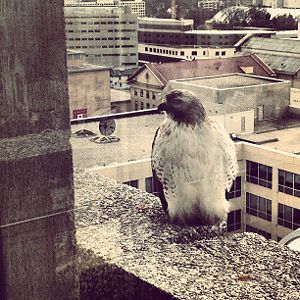Geometry and Topology Seminar 2019-2020: Difference between revisions
| Line 86: | Line 86: | ||
In this talk, in some reasonable special cases and a fairly complete manner, we will describe the relation between the moduli space of $G_{2}-$instantons and an algebraic geometry moduli on a Calabi-Yau 3-fold. | In this talk, in some reasonable special cases and a fairly complete manner, we will describe the relation between the moduli space of $G_{2}-$instantons and an algebraic geometry moduli on a Calabi-Yau 3-fold. | ||
===Antoine Song=== | |||
TBA | |||
==Fall Abstracts== | ==Fall Abstracts== | ||
Revision as of 22:01, 4 February 2020
The Geometry and Topology seminar meets in room 901 of Van Vleck Hall on Fridays from 1:20pm - 2:10pm.
For more information, contact Shaosai Huang.
Spring 2020
| date | speaker | title | host(s) |
|---|---|---|---|
| Feb. 7 | Xiangdong Xie (Bowling Green University) | Minicourse 1 | (Dymarz) |
| Feb. 14 | Xiangdong Xie (Bowling Green University) | Minicourse 2 | (Dymarz) |
| Feb. 21 | Xiangdong Xie (Bowling Green University) | Minicourse 3 | (Dymarz) |
| Feb. 28 | Kuang-Ru Wu (Purdue University) | Griffiths extremality, interpolation of norms, and Kahler quantization | (Huang) |
| Mar. 6 | Yuanqi Wang (University of Kansas) | Moduli space of G2−instantons on 7−dimensional product manifolds | (Huang) |
| Apr. 10 | Antoine Song (Berkeley) | TBA | (Chen) |
Fall 2019
| date | speaker | title | host(s) |
|---|---|---|---|
| Oct. 4 | Ruobing Zhang (Stony Brook University) | Geometric analysis of collapsing Calabi-Yau spaces | (Chen) |
| Oct. 25 | Emily Stark (Utah) | Action rigidity for free products of hyperbolic manifold groups | (Dymarz) |
| Nov. 8 | Max Forester (University of Oklahoma) | Spectral gaps for stable commutator length in some cubulated groups | (Dymarz) |
| Nov. 22 | Yu Li (Stony Brook University) | On the structure of Ricci shrinkers | (Huang) |
Spring Abstracts
Kuang-Ru Wu
Following Kobayashi, we consider Griffiths negative complex Finsler bundles, naturally leading us to introduce Griffiths extremal Finsler metrics. As we point out, this notion is closely related to the theory of interpolation of norms, and is characterized by an equation of complex Monge– Ampere type, whose corresponding Dirichlet problem we solve. As applications, we prove that Griffiths extremal Finsler metrics quantize solutions to a natural PDE in Kahler geometry, related to the construction of flat maps for the Mabuchi metric. This is joint work with Tamas Darvas.
Yuanqi Wang
$G_{2}-$instantons are 7-dimensional analogues of flat connections in dimension 3. It is part of Donaldson-Thomas’ program to generalize the fruitful gauge theory in dimensions 2,3,4 to dimensions 6,7,8. The moduli space of $G_{2}-$instantons, with virtual dimension $0$, is expected to have interesting geometric structure and yield enumerative invariant for the underlying $7-$dimensional manifold.
In this talk, in some reasonable special cases and a fairly complete manner, we will describe the relation between the moduli space of $G_{2}-$instantons and an algebraic geometry moduli on a Calabi-Yau 3-fold.
Antoine Song
TBA
Fall Abstracts
Ruobing Zhang
This talk centers on the degenerations of Calabi-Yau metrics. We will focus on the interactions between algebraic degenerations and metric convergence with highly singular behaviors in the collapsing case. As the complex structures degenerate, the collapsing Calabi-Yau metrics may exhibit various wild geometric properties with highly non-algebraic features.
First, as motivating examples, we will describe our recent results on the new collapsing mechanisms of K3 surfaces. Next, we will switch to higher dimensions and we will exhibit some entirely new constructions of degenerating Calabi-Yau metrics which are expected to work in broader contexts. Complex structures degeneration will be accurately characterized by the bubbling and singularity analysis in a geometric manner.
Emily Stark
The relationship between the large-scale geometry of a group and its algebraic structure can be studied via three notions: a group's quasi-isometry class, a group's abstract commensurability class, and geometric actions on proper geodesic metric spaces. A common model geometry for groups G and G' is a proper geodesic metric space on which G and G' act geometrically. A group G is action rigid if every group G' that has a common model geometry with G is abstractly commensurable to G. For example, a closed hyperbolic n-manifold group is not action rigid for all n at least three. In contrast, we show that free products of closed hyperbolic manifold groups are action rigid. Consequently, we obtain the first examples of Gromov hyperbolic groups that are quasi-isometric but do not virtually have a common model geometry. This is joint work with Daniel Woodhouse.
Max Forester
I will discuss stable commutator length (scl) in groups, and some gap theorems for the scl spectrum. Such results say that for various groups, scl of an element is always either zero or is larger than some uniform constant. I will discuss the cases of right-angled Artin groups and certain right-angled Coxeter groups. This is joint work with Pallavi Dani, Ignat Soroko, and Jing Tao.
Yu Li
We develop a structure theory for non-collapsed Ricci shrinkers without any curvature condition. As an application, we show that any Ricci shrinker whose second eigenvalue of the curvature operator is positive must be a quotient of sphere.
Archive of past Geometry seminars
2018-2019 Geometry_and_Topology_Seminar_2018-2019
2017-2018 Geometry_and_Topology_Seminar_2017-2018
2016-2017 Geometry_and_Topology_Seminar_2016-2017
2015-2016: Geometry_and_Topology_Seminar_2015-2016
2014-2015: Geometry_and_Topology_Seminar_2014-2015
2013-2014: Geometry_and_Topology_Seminar_2013-2014
2012-2013: Geometry_and_Topology_Seminar_2012-2013
2011-2012: Geometry_and_Topology_Seminar_2011-2012
2010: Fall-2010-Geometry-Topology
